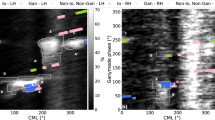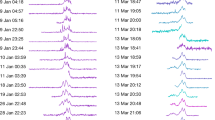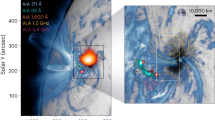Abstract
IN 1948 Allen1 discussed the reflexions of very high frequency radio waves from meteoric ionization, and recently Thompson2 has reported on meteor scatter bursts as recorded with a sweep frequency receiver. Similar observations have been made in Canada by a spectrum radiometer at the National Research Council's Radio Observatory in Algonquin Park, Ontario. The system is one in which twenty receivers having band-widths of 3 Mc./s. (now being changed to 1 Mc./s.) are spaced 5 Mc./s. apart in the frequency-range of 20–120 Mc./s., and the receiver outputs are commutated at a rate of 100 times per second. Since the input of the system is ‘wide open’ and the scanning rate is fast with respect to events having durations greater than 0.1 sec., the system has 100 per cent interception probability for such events. The display of the frequency-time domain of the bursts on an intensity modulated cathode ray tube is photographed on moving 35 mm. film. The output of the N.R.C. 10.7-cm. solar patrol radiometer is also recorded on the same film and appears in the illustrations as a horizontal line at the bottom of each photograph. This spectrum radiometer was designed to observe fine structure in solar radio emissions at metre wave-lengths. It has been operating since March 1961.
This is a preview of subscription content, access via your institution
Access options
Subscribe to this journal
Receive 51 print issues and online access
$199.00 per year
only $3.90 per issue
Buy this article
- Purchase on Springer Link
- Instant access to full article PDF
Prices may be subject to local taxes which are calculated during checkout
Similar content being viewed by others
References
Allen, jun., E. W., Proc. Inst., Rad. Eng., 36, 346 (1948).
Thompson, A. R., J. Atmos. Terr. Phys., 22, 161 (1961).
Rawlings, B., Roy. Astro. Soc. Canad. J., 55, 259 (1961).
Nat. Bur. Stand. Bull. CRPL-F 208, Part B (December 1961).
Elgaröy, O., Nature, 180, 862 (1957).
deJager, C., and van T Veer, F., K. Akademie van Wetenschappen, afd. Naturerkunde, 21, 3 (1958).
deGroot, T., Bull. Astron. Inst. Netherlands, 15, 229 (1960).
Vitkevich, V. V., and Gorelova, M. V., Astronomicheskii Zhurnal, 37, 622 (1960).
Author information
Authors and Affiliations
Rights and permissions
About this article
Cite this article
McNARRY, L. Forward Scatter of Radio Signals via Meteor Trails and Short-lived Solar Radio Bursts. Nature 193, 1271–1272 (1962). https://doi.org/10.1038/1931271a0
Issue Date:
DOI: https://doi.org/10.1038/1931271a0
Comments
By submitting a comment you agree to abide by our Terms and Community Guidelines. If you find something abusive or that does not comply with our terms or guidelines please flag it as inappropriate.



